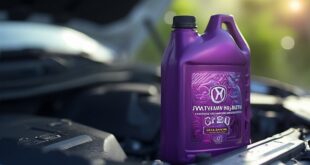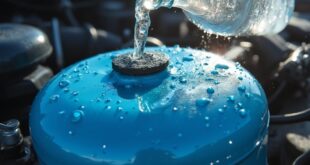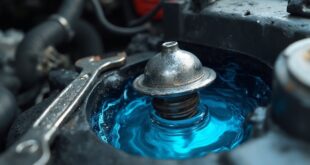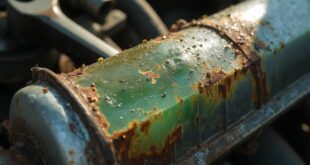If you find oil in your coolant reservoir, it's likely due to a blown head gasket, a faulty oil/coolant heat exchanger, or cracks in your engine. These issues let oil mix with coolant, leading to overheating and potential engine damage. You might notice symptoms like a milky substance under the oil cap or bubbles in the coolant reservoir. Addressing this quickly is key to preventing more serious problems down the road. There's more to learn about tackling this issue effectively.
Common Causes of Oil Contamination in Coolant
When you notice oil in your coolant reservoir, it's vital to understand the common causes behind this troubling issue.
One primary culprit is a blown head gasket, which lets oil seep into the coolant. Another cause could be a faulty oil/coolant heat exchanger, often found in high-performance vehicles.
Additionally, cracks in the cylinder head or engine block can lead to mixing.
Finally, human error, like accidentally mixing fluids during maintenance, can also result in contamination.
Identifying the source quickly is important to prevent further damage and guarantee your engine runs smoothly.
Risks Associated With Oil in Coolant
Oil in your coolant can pose serious risks to your engine's health, especially since it interferes with the coolant's ability to regulate temperature effectively. This can lead to overheating, low engine oil levels, and increased breakdown risks.
| Risk | Explanation |
|---|---|
| Engine Overheating | Inadequate temperature control can cause severe damage. |
| Low Engine Oil Levels | Oil leaks reduce lubrication, risking catastrophic failure. |
| Increased Breakdown Risks | Continued driving exacerbates existing issues, leading to costly repairs. |
Addressing these risks promptly can save you from extensive damage and costly repairs down the line.
Identifying Symptoms of Oil Contamination
Detecting symptoms of oil contamination in your coolant is essential for maintaining engine health. Look for a white, milky substance under the oil cap or milky brown engine oil—these indicate mixing.
Check for rust in the coolant, as it can signal corrosion or system failure. You may also notice bubbles forming in the coolant reservoir, suggesting overheating or air pockets.
Finally, watch for leaking coolant hoses, which can worsen engine issues. Addressing these symptoms promptly can save you from costly repairs and keep your engine running smoothly.
Stay vigilant to protect your vehicle's performance!
Steps for Repairing Oil Contamination Issues
To effectively tackle oil contamination in your coolant system, start with a thorough inspection and testing of the cooling system. Check for leaks and assess components like the head gasket and heat exchanger.
| Step | Action Required | Notes |
|---|---|---|
| 1. Inspect Components | Look for visible leaks | Pressure test for hidden leaks |
| 2. Repair or Replace | Fix faulty parts | Consider professional help |
| 3. Flush Coolant System | Remove all contaminants | Essential after repairs |
Taking these steps will help restore your cooling system and prevent further damage. Don't hesitate to consult a professional for complex repairs.
Importance of Professional Inspection and Repair
When it comes to addressing oil contamination in your coolant system, getting a professional inspection is crucial. Ignoring the issue can lead to serious engine damage and costly repairs.
Here's why you should prioritize professional help:
- Accurate Diagnosis: Experts can pinpoint the exact cause of contamination.
- Comprehensive Repairs: Professionals guarantee all affected components are repaired or replaced.
- Prevent Future Issues: Regular inspections can help catch problems before they escalate.
Don't risk further damage by attempting a DIY fix. Trusting a professional can save you time, money, and guarantee your engine runs smoothly.
Related Issues to Consider
Addressing oil contamination in your coolant system isn't just about fixing the immediate problem; it's also important to contemplate related issues that could arise.
For instance, a blown head gasket may not only leak oil but could lead to engine overheating if left unchecked. Additionally, you might find that low engine oil levels increase the risk of catastrophic failure.
Ignoring early symptoms can escalate repair costs considerably.
Finally, understanding that issues like faulty oil coolers or cracked cylinder heads contribute to oil contamination can help you prevent future problems and maintain your vehicle's performance effectively.
Stay vigilant!
Preventive Measures to Avoid Oil Contamination
Preventing oil contamination in your coolant system starts with regular maintenance and vigilant inspections.
By staying proactive, you can avoid costly repairs down the line. Here are three essential preventive measures:
- Regular Fluid Checks: Monitor your oil and coolant levels frequently, looking for any unusual mixing or discoloration.
- Scheduled Maintenance: Follow your vehicle's maintenance schedule, including timely oil changes and coolant flushes.
- Inspect for Leaks: Routinely check for signs of leaks around the head gasket, oil cooler, and hoses to catch problems early.
Stay informed, and keep your engine running smoothly!
Frequently Asked Questions
Can I Drive My Car With Oil in the Coolant?
You shouldn't drive your car with oil in the coolant. It can cause severe engine overheating and damage. Get your vehicle inspected immediately to prevent further complications and costly repairs. Safety first!
How Can I Test for Oil in My Coolant?
To test for oil in your coolant, check for a milky substance on the oil cap or inspect the coolant for a brownish hue. You might also use a dipstick to confirm contamination.
What Are the Long-Term Effects of Oil Contamination?
Long-term oil contamination can lead to severe engine overheating, reduced lubrication, and increased wear on components. If you ignore these issues, it'll likely result in costly repairs or even engine failure down the road.
How Much Does It Cost to Repair Oil Contamination?
Repairing oil contamination can cost anywhere from $500 to over $2,000, depending on the issue's severity and required repairs. You'll want to address it promptly to avoid further engine damage and higher expenses.
Will Changing the Oil Fix the Coolant Contamination?
Changing the oil won't fix coolant contamination. You'll need to address the underlying issue, like a blown head gasket or a cracked engine block, to prevent further damage and restore your vehicle's performance.
 Car Service Land Coupons for Oil change, Tires, Wheel alignment, Brakes, Maintenance
Car Service Land Coupons for Oil change, Tires, Wheel alignment, Brakes, Maintenance




